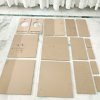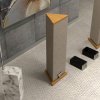Thanks for the offering but my driver is only 6.5" in size. Those hartzfield were designed for much larger drivers. I will share some pics of the OB in the morning and the details of the drivers to be used as well. As for now, i just finished designing a ported box for the intended drivers to evaluate its music fidelity/detail characteristics . Tomorrow plans will be sent to my workshop for its construction. Time to hit the bed, i am tired of yawning

So finally i had a breakthrough and found a thread on the world wide web for "how to use hornresp". There is a tool embedded in the sub menus that can determine if a driver is worth using in horn loading. After hours of playing and modelling through the software, i came to an understanding that my driver which is Flux audio MC2 6.5" mid woofer ain't worth the effort. The giveaway was its high "Q" . While it can still be used to get outstanding results of 130dbs at 60hz in room at 100watts, the enclosure it modelled was 3 times the volume compared to an equivalent fostex 6.5" full ranger.
To put this in perspective the box would be 7ft high , 3 ft deep, 3 feet wide.
I have the space to keep such behemoths, but its not worth the effort. So then ! I wont be making a BLH , for now atleast. I will see if i can get a hold on some fostex or other capable full rangers from friends visiting the land of red indians. Anyways, i will still share the ported box i modeled for these Flux drivers to my fellow DIY'ers. While the driver TS parameter are well suited for a TL ,I might do one after this build. Without furthur ado, here it goes...
The Flux drivers are from a Car Audio brand located in Germany , designed and manufactured in Germany and belongs to their Maestro Competition line up. Reason for choosing them was very simple, I had these lying around biting dust. The model is T160 MC2 , here is a link for them-
Flux T160 MC2 . The Tweeters are from the same brand , but this time these are manufactured by a very known brand called "Wavecor" to flux's specifications . The model of these tweeter is HT25 MC and here is a link for them
Flux HT 25 MC

Here is the frequency response curve. I tried getting it as flat as possible even at an expense of some Db's. I didn't take edge diffractions and many such minor accountables in consideration as this is far from the final design.

The box is tuned at 49 hz, but in room placement will help me achieve a little more below 49hz. The response from 45hz-200hz is withing a margin of 0.5 db. Which is quite good for a first try. Even the group delay is pretty acceptable, peaking at max 24ms at 43hz.

Now that some calculations were done , i finalized the external dimentions in Torres tuning calculator software and drafted the cabinet designs in AutoCad for it to get CNC'd.


Today i was able to make some time out of my schedule and finish the CNC work . Here are all the pieces, waiting for me to join them in holy music matrimony.

Hopefully by this weekend both the boxes will be ready for a music session with friends.
One question, what material you guys think or with personal experience chosen to dampen high frequencies of 200 hz and above inside the cabinet.
Interested in knowing your OB build. Would you share details on design, drivers ?
Thanks.
Hi yogi, as requested here are the pics of my unfinished build of OB. The drivers are from yamaha japan ,paper cone of of some japan specific tree pulp, yamaha tweeters from the studio monitor series ns6's .



It is supposed to look like this >>>














